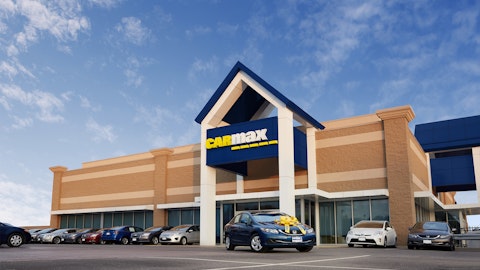Seth Basham: Thank you.
Bill Nash: Thank you, Seth.
Operator: Our next question will come from John Healy with Northcoast Research. Your line is open.
John Healy: Thank you. I just want to ask a follow-up question to your comment Bill about the conversion cycle. What’s happening after that initial disappointment with the consumer that they can’t afford the vehicle? Are you seeing them come back a couple of weeks later? Do you think they’re going to the private market? Are they just sitting on the sidelines? I know your sales folks are persistent, so we’d just love to kind of get perspective of what’s happening after they meet that surprise affordability roadblock.
Bill Nash: Yes, it’s a great question John. If I look at just web traffic and kind of use that as a proxy, we’re — we probably were averaging for the quarter about 37 million hits, which is up substantially year-over-year, and even up over the quarter, probably by about 3 million, 2 million to 3 million hits, which tells me, look, we’ve got a lot of folks that are out there and they’re interested in their window shopping, and some of those are absolutely repeat offenders. It’s, those aren’t unique, visits. As far as where they’re going, look, I think there’s a lot of folks unless, they just, their car isn’t running anymore. They’re just delaying the purchase. I do think that for some of the folks that cannot delay the purchase, I absolutely think that some of them are going down to a different level of car just to make sure that they can afford the monthly payments and to have reliable transportation.
Enrique Mayor-Mora: Yes, and I’ll tack onto that, John. I think, and that’s one of the real values of our finance product. You can easily apply online and then providing the answers back on all the vehicles, you again can very easily pivot and find something in your range, sort, filter accordingly. So I think that’s one of the things that we’re real excited about being able to provide that to our customer.
Bill Nash: Well, and the fact that having so many lenders on the platform basically competing for the customers also gives them the best interest rate, which is a key component of the monthly payment.
John Healy: Great. Thanks guys.
Bill Nash: Thanks, John.
Operator: Thank you. Our next question will come from Scot Ciccarelli with Truist. Your line is open.
Scot Ciccarelli: Thank you. Good morning, guys. So I think on the call you commented Bill that comps improved by month, but I think comparison challenges eased, if I’m not mistaken. So what would the monthly cadence look like on a two or three-year stack basis? And then kind of related to that, I know you guys don’t guide, haven’t for a very long time, but any reason to believe comps shouldn’t turn positive in the back half, just based on current trends and comparisons?
Bill Nash: Yes, Scot, if we look at the quarter specifically, I think I talked about the last call at the beginning of the quarter we’re starting out how the last quarter ended on average. And we did, as I said in the call, we did see improvement each month of the quarter and September so far is very similar to similar with a little bit of improvement to where August was. We’re not going to give guidance on the rest of the year, but as you said, I mean the comps do because of last year’s performance, the comps do get a little bit easier.
Scot Ciccarelli: Okay. So if I were just to break down 2Q, you’re not commenting on 3Q obviously, if I was looking at stacks, like is there a way to kind of look at on a two or three-year stack and help us understand whether there was improvement on that basis?
Enrique Mayor-Mora: Well, the two-year stack in the second quarter was better than the first quarter. So I think when it comes to intra quarter, we try not to talk too much about the details of month-to-month especially when looking over year, but I would tell you that second quarter, two-year basis better than the first quarter, as like Bill said.
Scot Ciccarelli: Okay, I’ll take the rest offline. Thanks guys.
Bill Nash: Thank you.
Operator: Our next question will come from Sharon Zackfia with William Blair. Your line is open.
Sharon Zackfia: Hi, good morning. I apologize if you answered this, my cell cut out and I had to redial in. But obviously you’re resuming the share repurchase program. What are the thoughts at this point on store openings? I don’t know if you even reiterated the plan for this year and I know you had kind of left the door open and maybe accelerating next year. So just thoughts on that or if perhaps the idea has changed in terms of harvesting more sales at existing locations rather than growing the store base meaningfully?
Bill Nash: Yes, good morning, Sharon. Yes, our outlook at this point, what we’ve already said hasn’t changed. So this year we have a few more stores that we’re going to open up, so that will get us to a total of five this year, plus the one standalone production facility that we’ve talked about down in the Atlanta market. We have not come out and said exactly the number of stores that we’ll be building next year yet. We’ll talk about that later on in the year, probably Q4 and let you know.
Enrique Mayor-Mora: Yes and that’s regular routine. We provide that update on an annual basis along with our CapEx guidance for the year.
Sharon Zackfia: Okay, thanks.
Bill Nash: Thanks, Sharon.
Operator: Our next question comes from Michael Montani with Evercore ISI. Your line is open.
Michael Montani: Great. Thanks for taking the question. I just wanted to ask on the credit front, if you can provide an update on credit availability? And then also to the extent some of the credit behavior was less favorable, how should we think about provisioning, given the current background is kind of $90 million the right number for now? Any color you can give there would be great.


